Manners, Customs, Clothing
 |
 |
 |
 |
 |
 |
 |
The Catholic Approach to Hiking - 2
Romanticism & Wanderlust: A Response to the
Industrial Revolution & Enlightenment
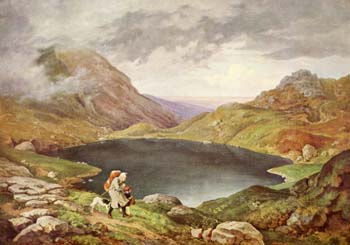
A German hiker with the wanderlust common to that people
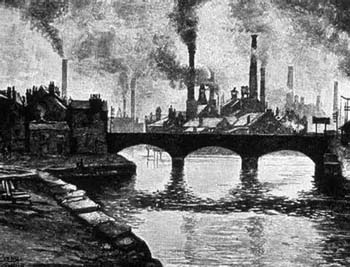
People swarm to the smog-filled massive cities & lose their connection with nature
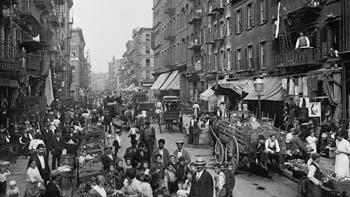
Life had become, as it were, a mechanical operation that no longer followed the changing seasons of the year. Before the Industrial Revolution, a majority of the population in Europe and America, were farmers or peasants. Even the town dwellers were surrounded by rural countryside. Holy day celebrations were interspersed throughout the year, giving time for rest and the enjoyment of family and community.
The new working class of the industrial era worked long hours, 10 to 14 hours a day, with scarcely any breaks for holidays. Many lived in tiny apartments in dirty dangerous districts, breathing the foul smog of the nearby factories. Although some city parks were established in order to relieve the working class, that small acreage of gardens hardly compensated for the growing population of laborers.
Victorian London, the setting of Charles Dickens’ novels, is a prime example of the new kind of city life centered only on work and play, and, for the very poor, mere survival. Did these people have time to walk in the countryside? Certainly not. Often they did not even have access to it.
Nor did many in the more comfortable classes wish to leave their lives filled with city entertainments and new inventions. Theaters, concert halls and ball rooms provided more excitement than the simple joys and labors of the natural world. As the new myth proposed, man had conquered nature and would put an end to all hardships through the engine of Progress. In reality these big industrialized cities were the drain of civilization.
Romanticism: a return to the rural simplicity of the past
As a response to the Industrial Revolution, the Romantic Movement entered the scene in the late 18th century. Romanticism, although revolutionary in its over-sentimentalism and exaggerated notion of love, was nonetheless a counter-movement to the Rationalism of the French Revolutionary thinkers who wanted reason to be god.

The Romantic movement popularized idyllic scenes of man in nature
Romanticism restored and encouraged people to leave the suffocating, factory-ridden cities and breathe the free air of the country and nature. Writers such as Fr. Thomas West of Scotland, and William Wordsworth of England encouraged people to stroll through the countryside and visit natural wonders in their respective countries.
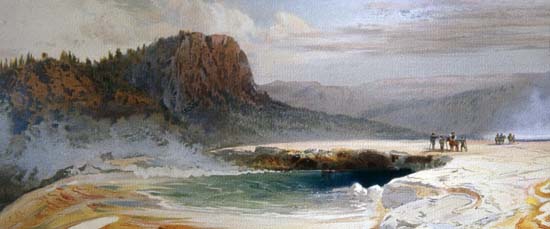
The founding of Yellowstone National Park in 1872
This movement engendered the emergence of national and state parks, established to preserve the most beautiful lands of every country for the enjoyment of everyone and save them from industrial abuses. Both men and women began to travel in order to hike and to camp in places with extraordinary natural wonders.
Wanderlust
The Romantic Movement found a great following in Germany, whose people have a great love of nature. The German word for hiking is wander, which was in use before 1900 and is the equivalent of the Middle English wandren. Walking was, and still is, a favorite pastime of the Germans.
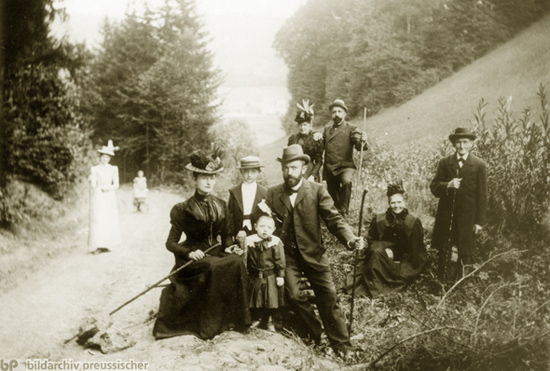
A bourgeoise family hiking in Thuringia;
below, a Victorian family on a hike in the country
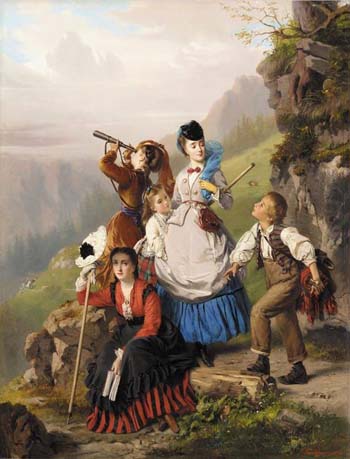
Mein Vater war ein Wandersmann
Und mir steckt's auch im Blut;
D'rum wand're ich froh, so lang ich kann
Und schwenke meinen Hut.
My father was a wanderer
And so it is also in my blood;
So I wander happily as long as I can
And twirl my hat.
In 1875, a new term expressing this Romantic spirit of traveling emerged in Germany, Wanderlust (longing to travel). It captured well the romantic ideal: to immerse oneself in nature by wandering around the wide world leaving off the cares and troubles of daily life.
What was missing is the spiritual element that was found in the medieval world. Instead of being motivated by love of God, the romantic hiker was moved by this wanderlust that, although a true longing in man, ultimately leads to instability and unhappiness because the sense of the purpose of life is lost.
Because the Romantic Movement was not based firmly on Catholic principles, its followers easily fell into a form of escapism, engrossing themselves in the sentiments of nature in order to escape life and run away from duty. In America, for example, the existentialist Henry David Thoreau abandoned society to live by himself “in nature” in a little cabin in the wilderness, concerned about no one but himself.
The modern notion of Wanderlust has adopted those errors of the romantic ideal, but it has also gone a step further. Today, men and women taken by wanderlust have an insatiable craving for traveling the world and seeing all of the most beautiful landscapes there are to be seen. Nothing ever satisfies their addiction to travel. They are without roots, endlessly seeking what they cannot find.
The desire for adventure & fitness
Whereas the romantic revival of hiking stressed the importance of contemplation and leisure, the modern hiking craze places emphasis on physical fitness and an unrestrained desire for adventure. Hiking has become the “sport” for those seeking adventure or for those who walk miles to be “in shape.”
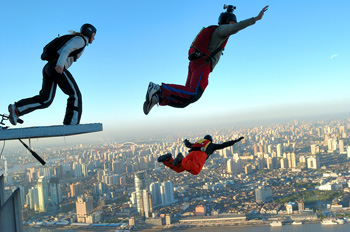
Persons addicted to the adrenaline rush of extreme sports will even risk their lives
It is not hard to see that this is another of the empty dreams of the modern world, with the plethora of adventure and extreme sports many people engage in or at least dream of partaking in. Although hiking does not fall into the direct category of extreme sports, the spirit in which some engage in it is the same. The feeling of exhilaration generated by such activities easily becomes an addiction.
Then there is other group, persons who hike because they are concerned about fitness and use hiking as a means to “work out.” Such persons have no eyes for the nature around them: Their primary concern is exercising their bodies. It is quite common on most hiking trails to pass groups of persons listening to revolutionary music, without any regard to the wildlife or their fellow hikers.
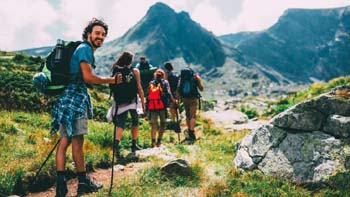
Interested in fitness, ‘personal growth’ or simply an insatiable lust for constant travel
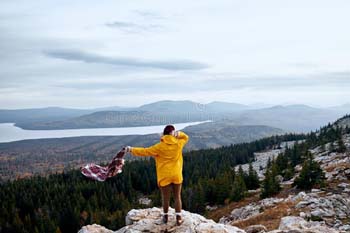
Obviously these hikers are looking for something more than this world can offer. They often find it in the New Age movement, where they can experience spiritual awakenings in nature. Going far beyond the romantic contemplation, the New Age encourages hikers to lose themselves in nature and feel the “power of the universe” inside of them.
Yet both ideals have a fatal flaw: there is no real end outside of self.
Hiking hardly has a legitimate purpose today. It has become artificial. Once it was a part of life, now it is simply an activity to pursue in free time, often a way to neglect the duty of one’s state in life, which is seen only as a means to provide the money needed to travel and enjoy life.
What is the counter-revolutionary position? While rejecting these modern tendencies, a counter-revolutionary can certainly hike, seeking above all the glory of God and contemplating His greatness in Creation. To foster a more medieval spirit, a counter-revolutionary can enter the natural world with the aim to transcend, to find God's reflection in nature, to seek the symbolism innate in plants, animals and terrains.
Further, those who hike should do so while maintaining their own dignity by wearing proper clothing and attire that counters the casual and immodest dress and spirit of the modern hiker, a topic to be discussed in further detail in the next article.
Given the artificial, revolutionary world most Catholics are forced to live in today, traveling to a state or national park or to a wildlife area to hike can not only be enjoyable but can also provide a way for Catholics to regain their sanity in the quiet calm of nature, where the Revolution has not yet been able to leave its mark.
Continued

Posted November 15, 2021
______________________
______________________








